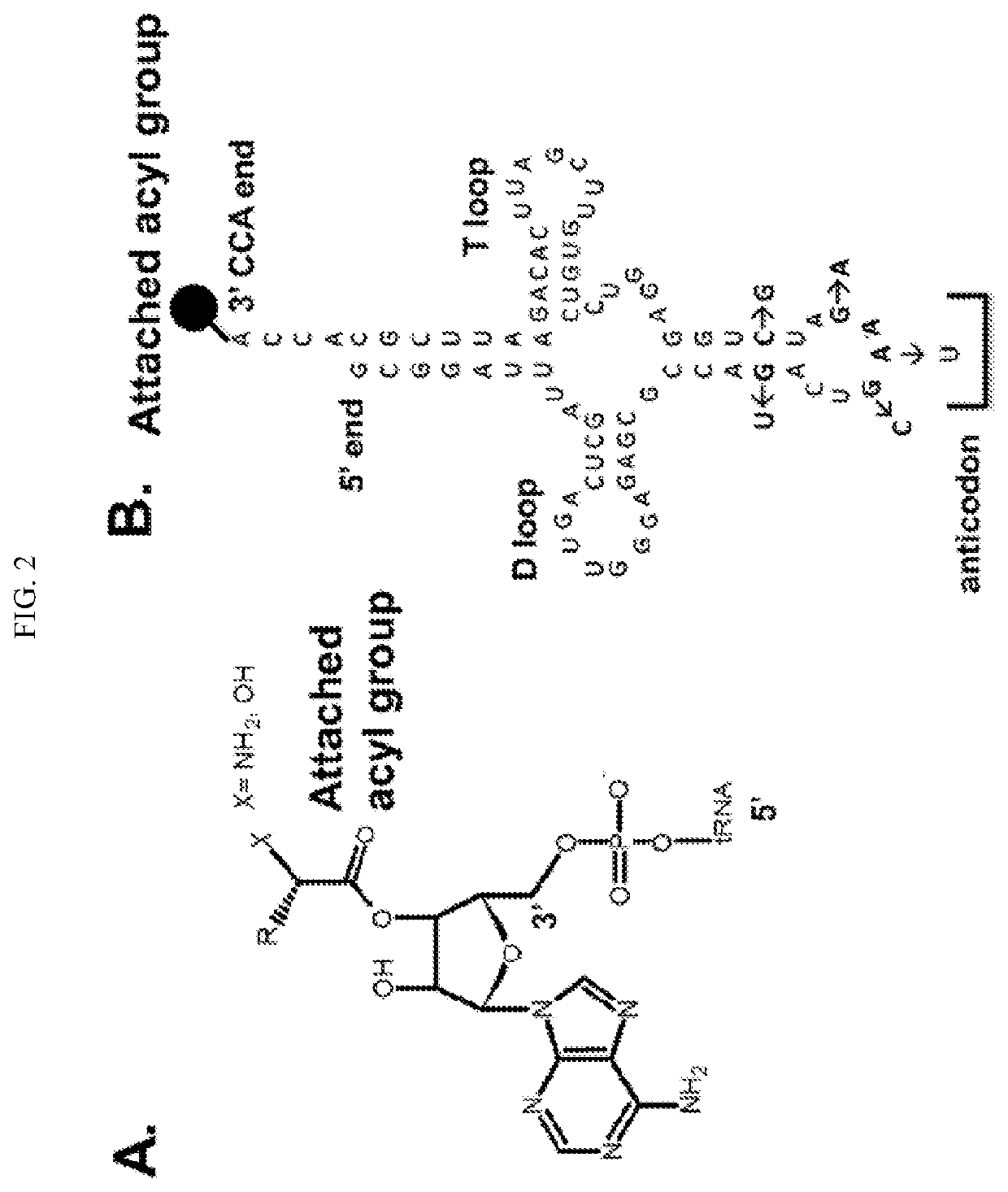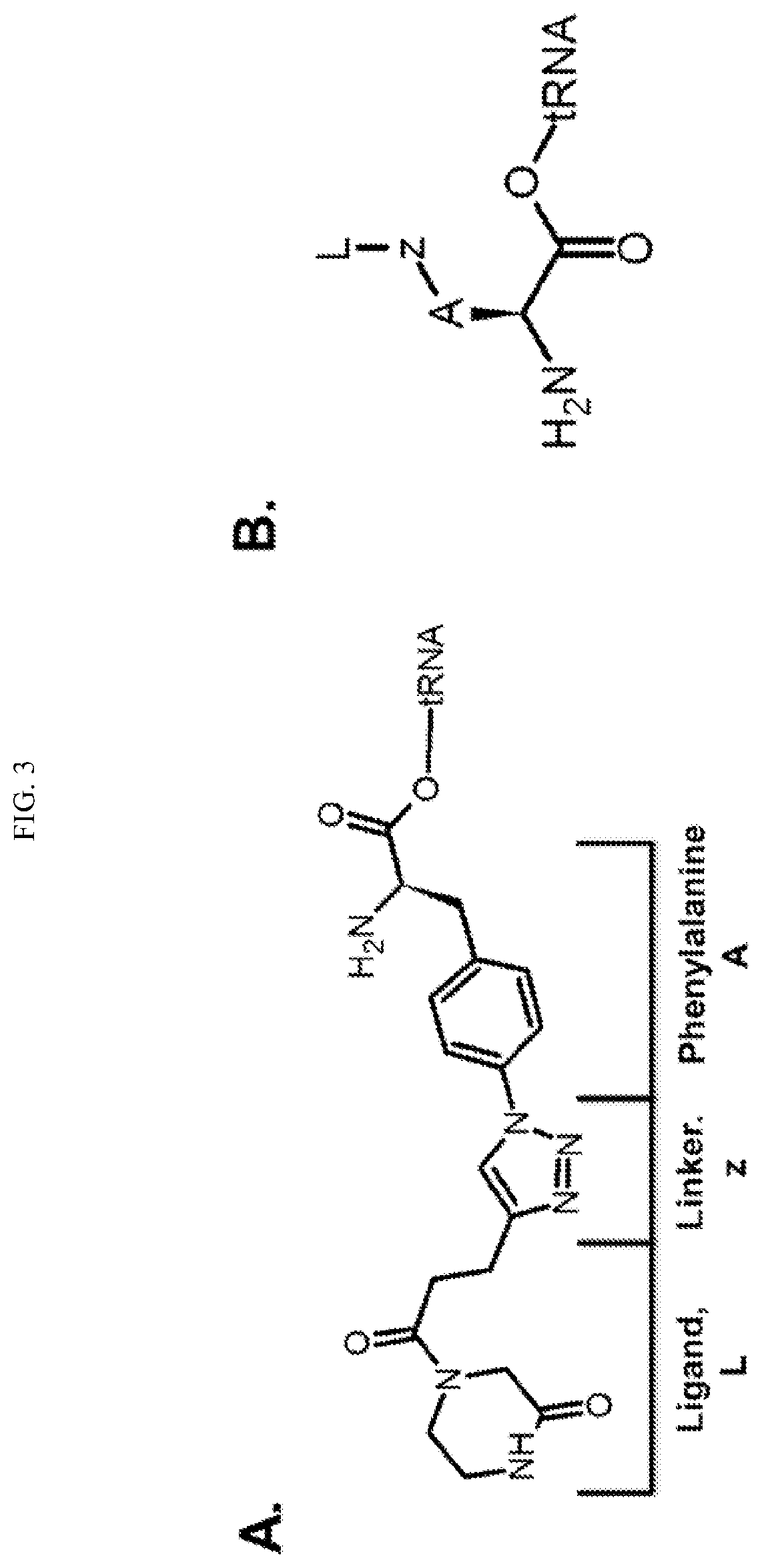Transfer RNA ligand adduct libraries
a technology of ribosomes and adduct libraries, applied in the field of transfering rna ligand adduct libraries, can solve the problems of large number of biological systems that are unrivaled in their ability to synthesize, high complexity of ribosome-directed translation machinery, and large number of drugs that cannot be explored by conventional drug discovery approaches
- Summary
- Abstract
- Description
- Claims
- Application Information
AI Technical Summary
Benefits of technology
Problems solved by technology
Method used
Image
Examples
example 1
Preparation of tRNA with a Highly Pure CCA 3′-Hydroxyl
[0251]This example illustrates a method for in vitro transcription of a cis-acting ribozyme fusion (Avis, J. M., Conn, G. L., & Walker, S. C. in Recombinant and in Vitro RNA synthesis: Methods and Protocols, Methods in Molecular Biology, vol. 941, pp. 83-98, (2012)) for the production of an optimized 75 nucleotide Methanococcus jannaschii (Mj) tRNACUATyr (Young, T. S., et al., J Mol Biol (2010) 395:361-374; Albayrak, C. and Swartz, J. R., Nucleic Acids Research (2013) 41:5949-5963) with a highly pure CCA 3′-hydroxyl, using the DNA template illustrated in FIG. 4. Optimized in vitro transcription reactions were performed in 20 mL glass scintillation vials containing 120 mM HEPES (pH 7.5), 20 mM NaCl, 30 mM MgCl2, 30 mM DTT, 2 mM spermidine, 0.011 μg / mL S. cerevisiae pyrophosphatase; 4 mM each of ATP, CTP, UTP, GTP at pH 7, 0.008 mg / ml T7 RNA polymerase, and 0.03 μg / mL of pGB014 DNA template plasmid. Transcription reactions were inc...
example 2
Preparation of tRNA-pGB028
[0253]tRNA transcribed from DNA plasmid pGB028 (FIG. 7) and refolded at 70° C. for 30 min was purified essentially the same as in Example 1. The transcription yields were significantly higher, but the purified tRNA was contaminated by a significant fraction of higher MW RNA (presumably HDV ribozyme, cf. FIG. 8).
example 3
Preparation of Mj TyrRS Enzyme Variants
[0254]This example illustrates the preparation of an engineered aminoacyl tRNA synthetase (aaRS) enzyme corresponding to a polyspecific aaRS enzyme from Methanococcus jannaschii (Mj) pCNF TyrRS described by Young, D. D., et al., Biochemistry (2011) 50:1894-1900 that may be used to charge tRNAs with non-canonical amino acids containing phenylalanine side chains substituted with reactive moieties. The T7-based plasmid pGB008, coding for pCNPhe Mj Tyrosyl RS with a C-terminal 6× His tag, was used to transform E. coli strain BL21 (DE3) and grown to an OD600 of 0.5-0.6 in 2 L of 2× Yeast Extract Tryptone medium (2×YT) divided into 3 Tunair flasks. Isopropyl-β-D-thiogalactoside (IPTG) was added to a final concentration of 1 mM and the cells were grown for additional 4-5 h at 37° C. Cells were harvested at 5,000×g for 15 min at 4° C. The cell pellet was washed by suspending it in 20 mL of lysis / equilibration buffer (300 mM NaCl, 10 mM imidazole, 50 mM...
PUM
| Property | Measurement | Unit |
|---|---|---|
| structure | aaaaa | aaaaa |
| pH | aaaaa | aaaaa |
| catalytic | aaaaa | aaaaa |
Abstract
Description
Claims
Application Information
 Login to View More
Login to View More - R&D
- Intellectual Property
- Life Sciences
- Materials
- Tech Scout
- Unparalleled Data Quality
- Higher Quality Content
- 60% Fewer Hallucinations
Browse by: Latest US Patents, China's latest patents, Technical Efficacy Thesaurus, Application Domain, Technology Topic, Popular Technical Reports.
© 2025 PatSnap. All rights reserved.Legal|Privacy policy|Modern Slavery Act Transparency Statement|Sitemap|About US| Contact US: help@patsnap.com



